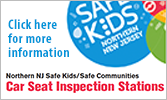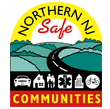Safer in 7
At Home
Know the basics: buckle up, wear a helmet, learn to swim, look both ways
When it comes to safety for your children, you know the basics: buckle up, wear a helmet, learn to swim, look both ways. Here are some lesser-known tips to make your family even safer in 7 easy steps.
- Tug on your kid’s car seat where the seat belt goes. If it moves more than 1” at the base, tighten it up.
About 73% of car seats are not installed correctly, but we can show you how to make sure your kid’s ride is safe. SafeKids.org/carseat. - Secure furniture and TVs. Mount flat screens and keep bulky-style TVs on a low and stable base, or recycle them.
Every two weeks, a child dies from a television or furniture tip-over. Check your house for furniture a child might try to climb and for TVs that could topple. - Check smoke and CO alarms monthly. Replace devices every 10 years. Replace batteries every year.
When a young child dies from a residential fire, a smoke alarm is usually either not present or not working because of dead or missing batteries. You can’t see, taste, or smell carbon monoxide, so your family needs both types of alarms. - Scan your home for places kids can get into medicine. It is pills in purses, vitamins on counters and medicine in daily reminder boxes that curious kids get into.
Every 8 minutes, a child goes to the ER for medicine poisoning, and almost 9 times out of 10, the medicine belongs to an adult. Look at your house from a child’s perspective to see what they can see or reach. - Check around your house for coin-sized button batteries.
They come in musical greeting cards, remote controls and key fobs. And of course, little kids pop them into their mouths in an instant. This happens more often than you might think: there are about 8 phone calls a day to poison control centers. - Ask your kid’s coaches if they have had concussion or sports safety training.
To keep kids staying active and enjoying sports, young athletes and coaches need to know how to stay hydrated, stretch thoroughly, use the right equipment and recognize the signs and symptoms of concussions. - TAKE OUR CHALLENGE: Take Action Against Distraction.
Distraction impacts driving, walking, bath time, just about everything. Here’s our challenge: take a month to notice times when you or your kids are distracted. Help each other remember to put down the phone (or whatever is diverting you) and focus on looking out for each other.
Additional Resources
KJ Feury RN APN, C
karenjean.feury@atlantichealth.org
Phone: 973-971-4327
Fax: 973-290-7350




